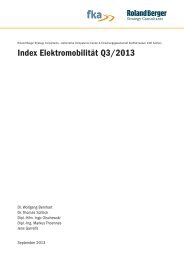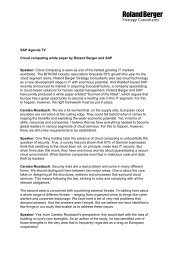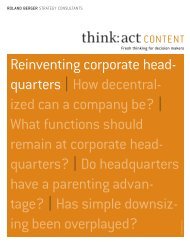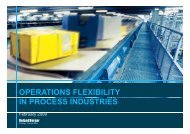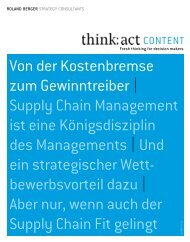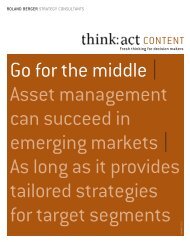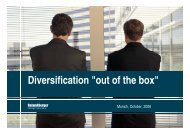CUSTOMER-CENTRIC RETAILING2. Create store clustersThe next step is to create clusters of stores to make themeasier to manage according to their individual needs andspecial characteristics. The criteria on which decisions arebased should no longer be the region, store size or position,but each store's customer-segment profile. Andthese can differ considerably.In one of our customer projects, we distinguished betweeneconomy, standard and premium stores. In an area wherethe customers were most interested in buying at discountprices, more space was devoted to the entry-level pricerange and the retailer's own brands. However, at locationswith an above-average percentage of consumers withhigher incomes who like to buy higher quality food, theproportion of premium products was significantly increased,particularly in categories such as wine andfresh foods.Of course, varying the range of products offered accordingto store clusters involves more organizational work: forexample, <strong>you</strong> have to create and update different planograms.However, the marked increase in customer satisfactiontranslates into a considerable economic benefit forthe retailer.3. Define <strong>you</strong>r target-customer segmentsBig retail groups try to satisfy practically every customer.No customer group can be neglected. Even so, they tooshould focus on strategic and high-value target-customersegments. Competition in the retail trade is growing all thetime, and the battle for customers is getting fiercer. Theresult is a further differentiation of formats. In food <strong>retailing</strong>,for example, this makes it possible to cater for specificcustomer needs in a more focused way; at least that is theaim of organic supermarkets, city-center stores and conveniencestores. Which makes it all the more importantfor <strong>you</strong> to keep <strong>you</strong>r customers loyal, raise <strong>you</strong>r "share ofwallet" and attract new customers. You will only succeedin this if <strong>you</strong> are constantly working on <strong>you</strong>r efficiency andmake <strong>you</strong>r format more attractive to <strong>you</strong>r target customers.CCR can help here, because the better <strong>you</strong> as a retailerunderstand the desires and needs of <strong>you</strong>r target customers,the more precisely and more efficiently <strong>you</strong> will beable to invest. In the same way, CCR reveals the productcategories in which <strong>you</strong> need to improve to satisfy thedifferent customer groups. To give <strong>you</strong> an example, in onecustomer project we found out that the members of the"convenience buyer" customer group were buying a significantlylower proportion of frozen products than from8
<strong>Customer</strong>-<strong>centric</strong> <strong>retailing</strong>relevant competitors. More detailed analysis revealedthat both the available product selection and the pricepositioning were suboptimal. This gap was quickly closedon the basis of the CCR approach, and the customersresponded positively.Such an approach can be used to deduce differentiatedstrategies for each customer group, the essential aimbeing to give the customers more added value by offeringmore attractive ranges and services and an improvedpricing policy.4. Align <strong>you</strong>r product category strategyOnce <strong>you</strong>'ve defined <strong>you</strong>r target-customer segments andstore clusters, the next step is to define <strong>you</strong>r strategicguidelines, category role, target-customer segments, etc.,for each category. It's best to start with a detailed analysisof the market position and the importance of the productcategory in the overall range. The next step is to determinethe product category's performance – compared to themarket and leading competitors, as well as from the pointof view of consumers. Based on the optimization potential<strong>you</strong> identify, <strong>you</strong> can then decide which customer segmentsto target in future and which ranges/products,prices and promotions to consider.5. Optimize <strong>you</strong>r rangeYour next aim is to provide a range of products that is asattractive as possible for the defined target-customersegments. To do this, <strong>you</strong> must find out which customersprefer which items, how loyal they are to these products,and how many buyers are reached by the individual products.The "RB Category Optimizer" is used to create adecision tree showing purchase decisions for each customersegment and product category. It reveals the logicfollowed by the customers when they are in the store –right down to their purchasing patterns at the shelves.This allows conclusions to be drawn for a more customerfriendlyproduct chronology and better merchandising.Optimizing <strong>you</strong>r range from the customer's perspective:Here is an example from the field of detergents. The laundrydetergent products (page 10, photo on the left) arearranged according to the traditional industry-dominatedshelf system – by brand and package size. As a result,the arrangement is not governed by how customers tendto buy. Products that customers feel belong together arearranged separately; the shelves offer little in the wayof orientation.The photograph on the right shows how customers wouldset out a shelf of laundry detergent products. The newla<strong>you</strong>t reflects how people actually buy: this is why, inthis case, products that customers think of as belongingtogether are placed next to each other on the shelves.Here we have copied the customer's first purchasedecision and separated liquid detergents from powderdetergents. We have also created vertical brand blocksto improve orientation.Today, decisions on inclusion and exclusion are stillvery much based on lists of fast and slow sellers andthe subsidies for advertising provided by manufacturers.However, such data does not give any indication of howimportant certain products are to individual customergroups. For example, although a high-quality skin creammight not be purchased very often, it could neverthelessbe an important product for the "conservative and brandconscious"customer segment. If <strong>you</strong> want to boost theloyalty of this customer group in the field of personalhygiene, <strong>you</strong> need to understand exactly which productshave a positive impact on customer satisfaction, whichproducts can be dispensed with, and whether there areany product gaps on the shelves.6. Optimize <strong>you</strong>r pricing strategyHow can <strong>you</strong> optimize <strong>you</strong>r pricing strategy based on abetter understanding of <strong>you</strong>r customers? As a general rule,food retailers tend to match their competitors' prices fortheir best-selling products with the aim of improving theirprice image among the customers. This "watering can"approach is a waste of margins because it involvesinvesting indiscriminately in the prices.9



